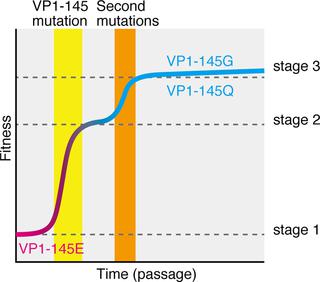PLoS Pathogens ( IF 5.5 ) Pub Date : 2020-03-18 , DOI: 10.1371/journal.ppat.1008428 Kyousuke Kobayashi 1 , Katsumi Mizuta 2 , Satoshi Koike 1

|
Enterovirus 71 (EV71) is a causative agent of hand, foot, and mouth disease (HFMD). However, this infection is sometimes associated with severe neurological complications. Identification of neurovirulence determinants is important to understand the pathogenesis of EV71. One of the problems in evaluating EV71 virulence is that its genome sequence changes rapidly during replication in cultured cells. The factors that induce rapid mutations in the EV71 genome in cultured cells are unclear. Here, we illustrate the population dynamics during adaptation to RD-A cells using EV71 strains isolated from HFMD patients. We identified a reproducible amino acid substitution from glutamic acid (E) to glycine (G) or glutamine (Q) in residue 145 of the VP1 protein (VP1-145) after adaptation to RD-A cells, which was associated with attenuation in human scavenger receptor B2 transgenic (hSCARB2 tg) mice. Because previous reports demonstrated that VP1-145G and Q mutants efficiently infect cultured cells by binding to heparan sulfate (HS), we hypothesized that HS expressed on the cell surface is a major factor for this selection. Supporting this hypothesis, selection of the VP1-145 mutant was prevented by depletion of HS and overexpression of hSCARB2 in RD-A cells. In addition, this mutation promotes the acquisition of secondary amino acid substitutions at various positions of the EV71 capsid to increase its fitness in cultured cells. These results indicate that attachment receptors, especially HS, are important factors for selection of VP1-145 mutants and subsequent capsid mutations. Moreover, we offer an efficient method for isolation and propagation of EV71 virulent strains with minimal selection pressure for attenuation.
中文翻译:

硫酸乙酰肝素附着受体是细胞培养适应过程中减毒肠病毒71突变体的主要选择因子。
肠病毒71(EV71)是手足口病(HFMD)的病原体。然而,这种感染有时与严重的神经系统并发症有关。鉴定神经毒力决定因素对于了解EV71的发病机理很重要。评估EV71毒力的问题之一是在培养细胞中复制过程中,其基因组序列会快速变化。尚不清楚在培养细胞中诱发EV71基因组快速突变的因素。在这里,我们举例说明了从HFMD患者中分离出的EV71菌株对RD-A细胞的适应过程中的种群动态。在适应RD-A细胞后,我们确定了VP1蛋白(VP1-145)残基145中从谷氨酸(E)到甘氨酸(G)或谷氨酰胺(Q)的可再现氨基酸取代,这与人类清除剂受体B2转基因(hSCARB2 tg)小鼠的减毒有关。因为以前的报道表明VP1-145G和Q突变体通过结合硫酸乙酰肝素(HS)有效感染培养的细胞,所以我们假设在细胞表面表达的HS是此选择的主要因素。支持该假设的是,HS耗竭和RD-A细胞中hSCARB2的过表达阻止了VP1-145突变体的选择。另外,该突变促进了在EV71衣壳的各个位置上二级氨基酸取代的获得,以增加其在培养细胞中的适应性。这些结果表明,附着受体,特别是HS,是选择VP1-145突变体和随后的衣壳突变的重要因素。此外,











































 京公网安备 11010802027423号
京公网安备 11010802027423号